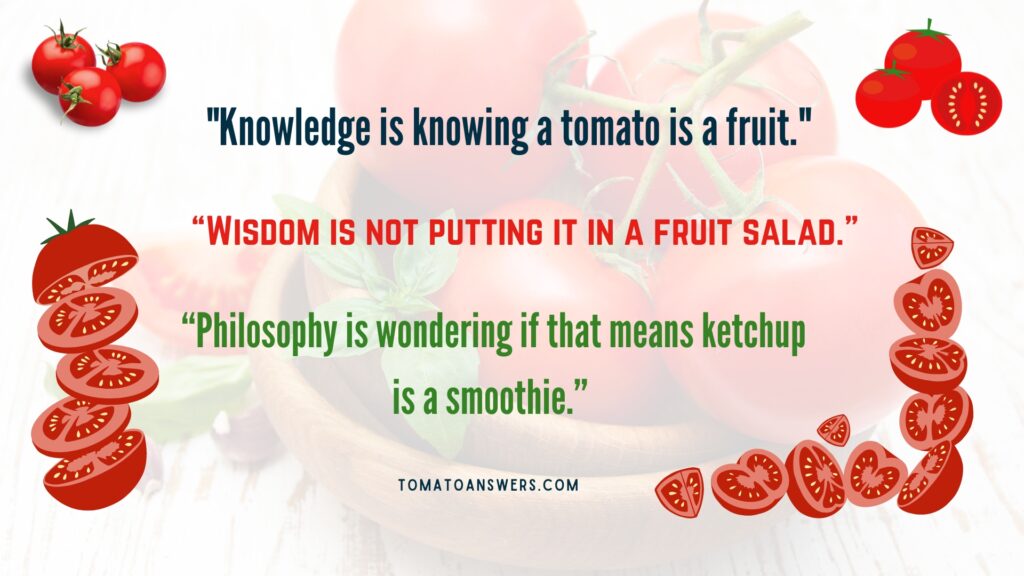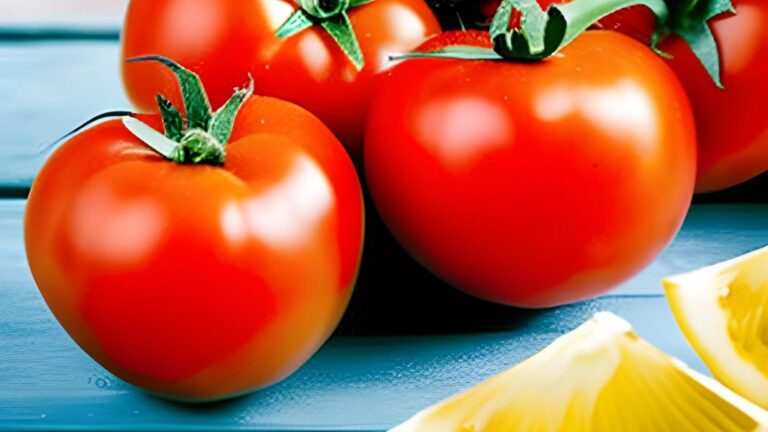In This Article
Key Takeaways
– 🍅 The botanical definition of a fruit is the mature ovary of a flowering plant, while vegetables encompass other plant parts.
– 🍅 Culinary and legal definitions categorize vegetables as savory and fruits as sweet, leading to tomatoes being labeled as vegetables due to their common use in savory dishes.
– 🍅 The 1893 Supreme Court case Nix v. Hedden solidified the classification of tomatoes as vegetables for tax purposes, despite their botanical classification as fruits.
– 🍅 Tomatoes have a complex classification due to the scientific debate, culinary practices, and cultural influences. The presence of seeds and the flavor and culinary use of tomatoes contribute to the discussion.
– 🍅 Regardless of their classification, tomatoes are a versatile ingredient, rich in nutrients like vitamin C and lycopene, and can be used in both sweet and savory dishes.
– 🍅 The historical trade laws and cultural customs influenced the classification of tomatoes as vegetables, leading to their widespread categorization as such.
Why is a Tomato A Vegetable and not a Fruit?
Have you ever wondered why the juicy red tomato is classified as a vegetable, not a fruit? The truth is that the classification of tomatoes has been a topic of debate for many years and is influenced by various factors.
This section will delve into the historical reasons behind classifying a tomato as a vegetable rather than a fruit. Understanding the past can help us better appreciate the present and answer some of the most puzzling questions about this beloved plant.

To truly understand why a tomato is a vegetable, one must explore the botanical, culinary, and legal definitions of fruits and vegetables and how they differ. Once we have a solid foundation, we can look at the factors that aided in the definitive classification of tomatoes as vegetables, including a famous Supreme Court case and the impact of trade and cultural practices.
Finally, we will examine tomatoes’ health benefits and nutritional value, as well as their versatility in various culinary preparations. So, let’s get started!
The Botanical Definition of Fruit and Vegetables
To understand why a tomato is classified as a vegetable, we must delve into the botanical definitions of fruit and vegetable. Botanically speaking, a fruit is the mature ovary of a flowering plant, usually containing seeds. Conversely, vegetables encompass other parts of the plant, such as the roots, leaves, and stems.
By this definition, a tomato is classified as a fruit. It develops from the ovary of the tomato flower and contains seeds. However, in culinary and legal contexts, classifying tomatoes as fruits or vegetables is a bit more complicated.
Culinary definitions often categorize vegetables as savory and fruits as sweet. Since tomatoes are commonly used in savory dishes, they are often labeled vegetables. Additionally, a 19th-century US Supreme Court case declared that tomatoes are vegetables for tax purposes, further solidifying their classification as such.
The Botanical Definition of Fruit and Vegetables
| Botanical Definition | Culinary and Legal Definitions |
|---|---|
| -Fruit is the mature ovary of a flowering plant | -Categorized based on sweetness (fruit) or savoriness (vegetable) |
| -Vegetables encompass other parts of the plant | -A 19th-century US Supreme Court case declared tomatoes as vegetables for tax purposes |
The Culinary and Legal Definitions
In addition to the botanical definition, the culinary and legal definitions also play a role in considering a tomato as a fruit or a vegetable. While many culinary uses of tomatoes are savory, they are often used in ways that align with our definition of fruit. Tomatoes are in sweet dishes like jams, pies, and ice cream!
From a legal standpoint, the classification of tomatoes as a vegetable was solidified in the 1893 Supreme Court case Nix v. Hedden. You can read the original court filings here for your history nuts: NIX v. HEDDEN, 149 U.S. 304 (1893).
The court ruled that tomatoes should be classified as vegetables for tax law since they were commonly used in savory dishes rather than desserts. While this decision has no bearing on the botanical classification of tomatoes, it did influence how we talk about them in everyday language.

The Misconception and the Supreme Court Case
Despite the botanical definition of a tomato as a fruit, it has long been considered a vegetable in culinary and legal contexts. This misconception dates back to the 1800s when trade laws imposed higher import taxes on fruits than vegetables.
To avoid these taxes, importers labeled tomatoes as vegetables, a classification that the United States Department of Agriculture eventually adopted.
This classification was further solidified in 1893 when the Supreme Court case Nix v. Hedden ruled that a tomato should be considered a vegetable for trade tariffs. The court acknowledged that a tomato is a fruit scientifically but stated that it should be classified based on its common usage and understanding among the public.
“Botanically speaking, tomatoes are the fruit of a vine, just as are cucumbers, squashes, beans, and peas. But in the common language of the people…all these are vegetables.” – Nix v. Hedden
Since then, the misconception of tomatoes as vegetables has persisted, and they continue to be used primarily in savory dishes rather than sweet ones.
Historical Culinary Uses of Tomatoes
- Tomatoes have been a staple food in many cuisines for centuries. However, it wasn’t until the late 19th century that they became widely popular in the United States. Before that, tomatoes were primarily used in Mexican and Italian dishes.
- In Mexican cuisine, tomatoes were often used in salsa and guacamole. Italian cuisine used tomatoes in pasta dishes, such as spaghetti and tomato sauce. In both cases, tomatoes were typically seen as a vegetable rather than a fruit.
- Interestingly, tomatoes were originally viewed with suspicion in the US and thought poisonous. It wasn’t until a public demonstration by Colonel Robert Gibbon Johnson in 1820, where he ate an entire basket of tomatoes in front of a crowd, that people widely accepted tomatoes as safe for consumption.
- As tomatoes became more popular, they were used in various dishes, including soups, stews, sandwiches, and salads. Today, tomatoes are a beloved ingredient in cuisines worldwide, and they continue to be used in both savory and sweet dishes.
The Scientific Debate
The scientific community has long debated whether a tomato should be classified as a fruit or a vegetable. While the botanical definition leans towards the former, other factors must be considered.
One argument is that fruits are typically sweet and used in desserts, while vegetables are savory and used in main dishes. However, this distinction is not always clear-cut, as many fruits are used in savory dishes, such as cranberries and rhubarb.
Another factor is the presence of seeds. According to the botanical definition, any fruit with seeds is true. However, some argue that a vegetable can have seeds like peppers and eggplants.
Ultimately, the scientific debate does not definitively answer whether a tomato is a fruit or a vegetable. Instead, it highlights the complexity and nuance of botanical classification and the need to consider multiple factors when deciding.
Tomato’s Place in Botany
From a botanical perspective, tomatoes are fruits. They develop from the ovary at the base of the flower and contain seeds, which are defining characteristics of the fruit. Botanically, a vegetable is any edible plant or part of a plant that isn’t a fruit or seed. By this definition, many foods commonly called vegetables, such as celery, carrots, and lettuce, are botanical fruits.
While the botanical classification of tomatoes as fruits is clear, they are typically considered vegetables in culinary and legal contexts. This is due to various historical and cultural factors and the practical use of tomatoes in cooking. Regardless of their classification, tomatoes are a versatile and nutritious ingredient with numerous health benefits.
The Science Behind Tomato’s Classification
- The scientific debate around the classification of tomatoes centers on the definition of fruit and how it relates to the characteristics of tomatoes.
- While tomatoes are undoubtedly fruits in a botanical sense, some argue that their flavor and culinary use make them more similar to vegetables. Others point to the fact that tomatoes are often treated as vegetables in cooking and are rarely used as the primary sweet component of a dish.
- Ultimately, the botanical classification of tomatoes as fruits is well established, but the culinary and cultural factors that have led people to consider them vegetables cannot be ignored.
- Regardless of the classification, however, it is clear that tomatoes are a valuable ingredient in a wide range of dishes and offer significant health benefits.
The Influence of Trade and Customs
The classification of tomatoes as a vegetable rather than a fruit is not only rooted in biology and culinary practices but also shaped by trade and cultural influences. In the late 1800s, the United States government imposed a tariff on imported vegetables, including tomatoes, but not on imported fruits.
As a result, importers argued that tomatoes should be classified as vegetables to avoid paying the tariff, leading to the landmark Supreme Court case of Nix v. Hedden in 1893.
“Botanically speaking, tomatoes are fruits, but in the common language of people, whether sellers or consumers of provisions, all vegetables are classified under certain practical regulations as having a distinctive character. They are usually served at dinner in, with or after soup, fish or meats, which constitute the principal part of the repast, and not, like fruits, generally as dessert.”
Despite the scientific facts, the Court ruled that tomatoes should be classified as vegetables based on their common usage in culinary contexts. The decision reflected the cultural norms and practices of the time, where tomatoes were primarily used in savory dishes and served as a side dish rather than a dessert.
Health and Nutritional Profile of Tomatoes
Regardless of their classification as a fruit or vegetable, tomatoes are a nutritious addition to any diet.
| Nutrient | Amount per 100g |
|---|---|
| Calories | 18 |
| Protein | 0.9g |
| Fat | 0.2g |
| Carbohydrates | 3.9g |
| Fiber | 1.2g |
| Vitamin C | 21% of the Daily Value (DV) |
| Vitamin K | 11% of the DV |
| Potassium | 5% of the DV |
Tomatoes are also a good source of lycopene, a powerful antioxidant linked to a reduced risk of heart disease and certain types of cancer.
Studies have shown that the nutritional value of tomatoes is enhanced when they are cooked, as the heat releases more lycopene and makes it easier for the body to absorb.
So whether you classify them as fruits or vegetables, there’s no denying that tomatoes are a healthy choice for any meal.
Tomato is a Versatile Ingredient
- Whether you consider a tomato a fruit or a vegetable, there’s no denying its versatility in the kitchen. From sweet to savory dishes, tomatoes can be used in various delicious ways.
- Take a classic Caprese salad, for example. The combination of fresh tomatoes, creamy mozzarella, and fragrant basil is a simple yet flavorful dish perfect for a light summer lunch or as an appetizer.
- But tomatoes aren’t just for salads. They can be roasted and blended into a rich tomato sauce or soup or sliced and layered onto a pizza for a juicy flavor.
- If you’re looking for a sweet treat, try making a tomato jam or chutney to spread on toast or serve with cheese. The natural sweetness of tomatoes pairs perfectly with warm spices like cinnamon and cloves.
- Tomatoes also make a great addition to smoothies and juices. Their bright, tangy flavor balances the sweetness of other fruits like strawberries or raspberries while adding a healthy dose of vitamins and antioxidants.
So whether you’re team fruit or team vegetable, there’s no denying the deliciousness of a ripe, juicy tomato.
The Tomato Conundrum: Frequently Asked Questions
As we’ve explored, classifying tomatoes as a fruit or vegetable is complicated, with diverse factors at play. Here are some common questions and misconceptions related to this debate:
Are tomatoes a fruit or vegetable?
Botanically speaking, tomatoes are fruits. However, for culinary and legal purposes, they are considered vegetables.
Why are tomatoes considered vegetables?
In the late 1800s, a Supreme Court case involving imported tomatoes solidified their classification as vegetables for taxation purposes. Additionally, culinary traditions and customs have historically treated tomatoes as vegetables, leading to their widespread categorization as such.
Can tomatoes be both fruits and vegetables?
Yes, since the classification of a tomato as a fruit or vegetable depends on the context in which it is being discussed. Botanically, they are fruits, while culinarily and legally, they are vegetables.
Is there any scientific proof that tomatoes are fruits?
Yes. Tomatoes contain seeds and develop from the flower of a tomato plant, which are both characteristics of fruits according to the botanical definition.
Do the health benefits of tomatoes change depending on their classification?
Regardless of whether a tomato is classified as a fruit or a vegetable, it contains numerous health benefits and is a nutritious addition to any diet.
Why is it important to know whether a tomato is a fruit or a vegetable?
While the classification may not significantly impact the health benefits or culinary uses of tomatoes, understanding the different definitions and historical factors can deepen our appreciation and knowledge of these versatile ingredients.
Conclusion: Tomato A Fruit Or A Vegetable!
After exploring the various factors that contribute to the classification of tomatoes as a vegetable rather than a fruit, it’s clear that the answer isn’t straightforward.
Historically, cultural and legal practices have significantly shaped our perception of tomatoes as a vegetable, while the botanical and scientific definitions suggest a different classification.
Despite this confusion, it’s important to note that classifying tomatoes as a fruit or vegetable doesn’t impact their nutritional value or versatility in the kitchen. Tomatoes are a nutrient-dense ingredient that can enhance many sweet and savory dishes.
So, is a tomato a fruit or a vegetable?
The answer ultimately depends on the context in which it’s being considered. Culinary and legal practices categorize it as a vegetable, while the botanical and scientific definitions suggest it’s a fruit. However, regardless of their classification, tomatoes remain popular and versatile in many dishes worldwide.
Have more questions about the tomato conundrum?
If you still have questions or want to learn more about the classification of tomatoes, check out our Tomato FAQ section for answers to commonly asked questions.
Are You New To Tomato Answers?
If you are new to Tomato Answers, then here are a few resources that will help you:
- Ready for a charming sequel? Why did the tomato blush again? Discover the riddle in – Why Did The Tomato Blush 2?
- Discover effective strategies to speed up the growth of your tomatoes in – Ways To Speed Up Tomato Growth
- Learn the importance and techniques of pinching off tomato plant flowers in – Pinch Off Tomato Plant Flowers
- Discover the potential benefits of using Epsom salt for your tomato plants in – Epsom Salt Tomato Plants
- What are the food preferences of sugar gliders? Do they enjoy tomatoes? Find out in – Can Sugar Gliders Eat Tomatoes?
- Welcome to Tomato Answers! Your one-stop shop for all your tomato-related questions! – Tomato Answers


